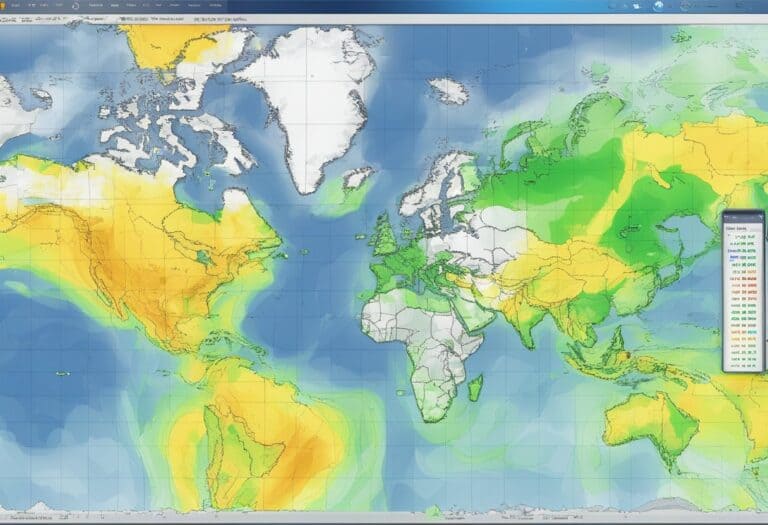Dressing appropriately for the weather is crucial for comfort, health, and enjoyment of outdoor activities. When the temperature is anywhere between 30 and 80 degrees Fahrenheit, your clothing choices can greatly influence how you feel throughout the day.
This range covers everything from freezing conditions where layering is essential to maintain body heat, to warmer situations where lighter clothing helps keep you cool.
Each temperature bracket, from the chill of 30-degree weather to the warmth of 80 degrees, requires a different approach to dressing. Whether it involves insulated garments and thermal layers to combat the cold, or breathable fabrics and loose-fitting clothes to manage heat, understanding how to adjust your attire will enhance your ability to navigate these varying climates confidently.
From freezing to balmy, dress in layers with breathable fabrics, adjusting for activity and unexpected chills.
Understanding Weather and Temperature
When you plan your daily attire, understanding the impact of weather and temperature is crucial. Weather refers to the atmospheric conditions over a short period, while temperature is a measure of how hot or cold the atmosphere is. The forecast provides predictions about these elements, helping you prepare for the day ahead.
Seasonal Changes: Weather patterns follow the cycles of the seasons—winter, spring, summer, and fall—each with its characteristic temperature range. Summer typically brings higher temperatures, while winter is mostly associated with cold. Spring and fall act as transitional periods with more moderate conditions.
Atmospheric Elements:
- Temperature: Indicates the degree of warmth or coldness.
- Humidity: Reflects the amount of moisture in the air, affecting how temperatures feel on your skin.
Reading the Forecast:
- Highs and Lows: Pay attention to predicted temperature ranges for the day.
- Precipitation: Rain, snow, or sleet can influence your choice of waterproof or insulating clothing.
- Wind: Strong winds can make it feel colder than the actual temperature, known as the wind chill effect.
How to Dress for Various Temperatures:
- 30-40°F (-1-4°C): Layer with thermal underwear, fleece, and a heavy coat.
- 50-60°F (10-15°C): A light to medium-weight jacket or sweater.
- 70-80°F (21-27°C): Comfortable in t-shirts, shorts, or light dresses.
When preparing for the day, consider both the temperature and the humidity, as high humidity can make warm temperatures feel hotter, while low humidity can make the cold feel piercing. Remember, clothing choices may vary depending on personal comfort and activity level.
30-Degree Weather: Dressing for the Freezing Cold
In 30-degree weather, the right clothing is not just about comfort, but about safety. Your primary goal is to maintain warmth while also managing moisture to avoid dampness that can lead to a chill.
Start with base layers that have moisture-wicking properties to keep your skin dry. Materials like merino wool or synthetic fibers are excellent for this purpose. On top of that, add an insulated middle layer, such as a fleece jacket, for additional insulation.
Heavy coats are a necessity, especially those like a down jacket that provide significant warmth without the weight. The down material acts as a barrier, trapping heat and keeping the icy cold at bay. Ensure your jacket also has a protective outer shell to shield against wind and snow.
Hats and gloves are vital; go for options lined with thermal materials that conserve heat loss from your head and hands. Your head is especially prone to losing body heat, so a well-fitted hat can make a significant difference in how warm you feel.
Don’t overlook your feet – insulated boots with a waterproof exterior are your best friends in cold weather. They should be sturdy enough for snow, yet comfortable for longer wear periods.
Remember, in 30-degree weather, it’s not just about piling on clothes—it’s about smart layering and materials that work together to keep you warm and dry through the day.
40-Degree Weather: Layering Strategies

When dressing for 40-degree weather, it’s crucial to master the art of layering to maintain comfort. The goal is to stay warm without overheating, especially since temperatures can fluctuate throughout the day.
Start with a base layer that’s moisture-wicking. This could be a long-sleeved top made from materials like Merino wool or synthetic fibers designed for thermal regulation.
Next, add a mid-layer such as a sweater or cardigan. Choose a knit density based on your activity level—a thick knit for low activity or a lighter one if you’ll be moving around more.
For your lower body, consider thicker pants, potentially lined for additional insulation.
Upper Body Layers:
- Base layer: Thermal top
- Mid-layer: Sweater/Cardigan
- Outer layer: Windproof jacket
Lower Body Layers:
- Insulated trousers
Accessorize with wool socks to keep your feet warm. For the outermost layer, a windproof shell or jacket is key, as it will protect against sudden chilly gusts. Materials like leather offer both style and wind resistance.
Consider the situation; a brisk walk may require fewer layers, while sitting for long periods could demand an extra layer for warmth.
Lastly, a glance at a weather app before heading out will guide your choices, ensuring you’re prepared for any changes in what to wear in 40-degree weather.
50-Degree Weather: Transitional Attire
When you’re dressing for 50-degree weather, which often falls in the transitional seasons of spring and fall, strike a balance between comfort and adaptation to fluctuating temperatures.
Upper Body: Begin with a long-sleeved shirt—a staple that keeps your arms protected from the cooler breeze. Layering is key, so consider adding a lightweight sweater or cardigan that you can remove easily if you get warm. For the outer layer, a light jacket or a windproof jacket can provide protection against unexpected gusts.
Lower Body: Both jeans and leggings serve as versatile options for 50-degree weather. They offer enough warmth without the bulk, making your movements comfortable and unencumbered.
Accessories: A scarf can be both a fashionable and functional addition to your ensemble. It offers extra warmth and can be easily taken off.
Footwear: Close-toed shoes are generally the best choice. Boots or sneakers can keep your feet warm and dry, especially if you encounter any rain or chilly wind.
- Recommended Outfit:
- Upper Body: Long-sleeved shirt, Sweater, Light jacket
- Lower Body: Jeans or Leggings
- Accessories: Scarf (optional)
- Footwear: Boots or Sneakers
Remember, the goal is to remain comfortable as you navigate through the day. Transitioning between indoor and outdoor environments may require a few adjustments, so opt for clothing that you can easily layer.
60-Degree Weather: Balancing Warmth and Coolness
When you’re dressing for 60-degree weather, your aim is to strike a perfect balance between warmth and coolness, as this temperature range can feel quite moderate. It’s often a transitional climate where layers become your best friend, allowing you to adjust easily to the varying conditions of the day.
Upper Body: Begin with a basic t-shirt, perhaps made of a breathable material such as cotton, which is versatile enough to wear alone or under additional layers. Over your t-shirt, consider donning a cardigan or a light sweater. These items are ideal for 60-degree weather because they add warmth without being overly heavy.
- T-shirts (preferably in breathable fabrics)
- Cardigans or lightweight sweaters
Lower Body: Long pants or jeans are go-to options for your legs. They provide coverage and comfort without the weight of heavier winter clothing. The denim’s thickness is just right for that slight chill in the air.
- Long pants (choose materials like lightweight wool or cotton)
- Jeans (a classic that pairs well with almost anything)
Footwear: When it comes to shoes, loafers and running shoes are both practical selections. Loafers provide a stylish yet comfortable option if you’re aiming for a semi-casual look, while running shoes offer support and ease if you anticipate being on your feet for long periods or navigating varying terrains.
- Loafers (for style and comfort)
- Running shoes (for support and active days)
By layering smartly and choosing materials that offer breathability and comfort, you can enjoy your day in 60-degree weather with ease. Remember that the key is to adapt, so always have an extra layer on hand to accommodate any unexpected changes in temperature.
70-Degree Weather: Embracing Mild Warmth
When the thermometer hits that sweet spot of 70 degrees, it’s all about embracing the mild warmth with the right attire. You’ll want to lean towards clothing that offers comfort and versatility for this temperate weather.
Upper Body: Opt for a light tank top or short-sleeve blouse. Fabrics like cotton and linen are ideal, as they are breathable and help maintain a comfortable body temperature. Avoid polyester if possible, as it might not offer the same level of breathability.
Lower Body: Shorts or skirts are perfect for 70-degree weather. They allow air circulation and provide a comfortable level of exposure. A-line or flowy dresses also work well, giving you freedom of movement and a touch of elegance.
Layering: Even in mild warmth, temperatures can fluctuate. Having a light cardigan or an airy pullover on hand is wise for cooler moments, especially in the evenings.
Footwear: Sneakers can complement your casual attire, or you could opt for sandals if you prefer an open shoe.
Accessories: Don’t forget to accessorize. A wide-brimmed hat or sunglasses protect you from the sun, while a lightweight scarf can add a pop of color to your outfit and is easy to remove if it gets warmer.
Remember, the key to comfort in 70-degree weather is choosing garments that feel good on your skin and allow easy transition through various indoor and outdoor settings.
80-Degree Weather: Keeping It Cool
In 80-degree weather, you’re entering the quintessential summer heat. Here’s how to stay cool and stylish:
- Tops: Opt for lightweight, breathable materials like cotton or linen. A loose-fitting tank or vest allows air circulation, helping moisture evaporate and keeping you cool.
- Bottoms: Shorts in a similar breathable fabric will maximize comfort. Choose styles that are roomy enough to avoid sticking to your skin when you’re active or running errands.
Footwear: It’s prime time for flip-flops or sandals, ensuring your feet aren’t constricted and can breathe freely. For more foot support, choose breathable, water-resistant sneakers.
Accessories: Always include sun protection as part of your attire. A wide-brimmed hat and UV-protective sunglasses are your allies against the sun’s rays. Additionally, carry a water bottle to stay hydrated; moisture loss from sweat in the heat can be deceptive.
Materials: Gear up with synthetic fabrics designed to wick away moisture, drying quickly to keep you comfortable. Garments labeled as “cooling” or “sports” often feature these materials.
When choosing what to wear in 80-degree weather, your outfit should be a balance of fashion and function. Light colors reflect the sunlight and contribute to keeping the body temperature down, so consider pastels and whites over darker shades. Remember: the goal is to remain cool, light, and protected while enjoying the warmth of the season.
Accessorizing for the Weather
When contending with different temperatures, you’ll want to consider how accessories alter your comfort and protection. Layering is key, and the right accessories can provide both style and function.
30-40°F
- Gloves: Insulated gloves are essential.
- Hat: Choose a thick, knitted beanie or similar to retain heat.
- Scarf: A wool scarf will shield your neck from the cold.
- Boots: Insulated and waterproof boots are critical for warmth and dryness.
50-60°F
- Lightweight gloves: A thinner pair for brisk mornings.
- Hat: A lighter beanie can suffice, or a cap on sunnier days.
- Socks: Thicker socks add comfort without overheating.
- Waterproof jacket: Useful for unpredictable showers.
70-80°F
- Capri: Consider capri pants for breathability over full-length options.
- Footwear: Opt for moisture-wicking socks with comfortable, breathable shoes.
- Hat: A breathable, wide-brimmed hat will protect you from the sun.
For all Ranges:
- Umbrella: Always handy for sudden downpours.
- Traction Footwear: Whether it’s boots or shoes, ensure they offer good grip.
- Moisture-wicking Layers: They’re invaluable for staying dry and comfortable, whether from rain or sweat.
Remember, your comfort is paramount when accessorizing for the weather, so adjust layers as needed based on your activity level and the day’s forecast.
Clothing Materials and Technologies
When dressing for varying temperatures, understanding the materials and technologies behind your clothing is crucial. Your choices impact comfort, protection, and functionality.
30-40°F (1-4°C)
- Outerwear: Your outer layer should be windproof and waterproof. Materials like Gore-Tex can offer protection from the elements.
- Insulation: Down jackets are excellent for insulation. Look for options with a high fill power for maximum warmth.
50-60°F (10-16°C)
- Fabrics: Opt for synthetic fabrics like polyester for their moisture-wicking properties. Lightweight fleece can provide adequate warmth.
- Footwear: Leather sneakers are a solid choice—stylish yet practical.
70-80°F (21-27°C)
- Wearability: Choose breathable materials such as acrylic fabric to stay cool and comfortable.
- Accessories: Don’t forget wool socks. They can help regulate temperature and manage moisture, even in warmer weather.
Material Technologies
- Phase Change Materials (PCMs): Advanced textiles incorporate PCMs which adapt to body temperatures, offering comfort in a broad range of conditions. These can be found in specialized thermal regulation clothing.
- Moisture Control: Fabrics treated with moisture management technology, like nanomoisture technology, help wick away sweat, keeping you dry and comfortable.
Remember to layer appropriately and choose the right materials for your clothing to enhance your experience in diverse weather conditions.
The Importance of Dressing Appropriately
When you face different weather conditions, your clothing choices can play a pivotal role in maintaining your comfort and safety. Dressing appropriately helps to regulate your body temperature, whether the environment is warm or cold.
In 30 to 40-degree weather, layering is key. Start with a base layer that wicks away moisture, add an insulating layer, and finish with a protective outer layer. For example:
- Base layer: Moisture-wicking synthetic or wool shirt
- Insulation: Fleece or lightweight down jacket
- Outer layer: Water-resistant and windproof jacket
As the temperature rises to 50 to 60 degrees, you can often shed the heavier insulating layer, but having a light sweater or jacket handy is wise for unexpected chills.
Once it climbs to 70 to 80 degrees, dressing in light, breathable fabrics will help you stay cool. Clothing made from cotton or linens are ideal as they allow air circulation and help to wick moisture away from your body.
| Temperature Range | Suggested Layers |
|---|---|
| 30-40°F | Base, Mid, Outer |
| 50-60°F | Base, Light Mid |
| 70-80°F | Light Clothing |
Regardless of the temperature, always consider the UV index and humidity when choosing your dress; sometimes, the sunshine or moisture in the air will affect how hot or cold you feel.
Strategically selecting your clothing and layers according to the weather not only ensures that you preserve your comfort but also that you are prepared for any variations that the day might bring.
Sports and Outdoor Activities
When engaging in sports and outdoor activities in varying temperatures, appropriate attire is essential for comfort and performance. Here’s how to dress smartly for your outdoor workouts:
30-40°F:
- Base Layer: Opt for moisture-wicking fabrics that keep sweat away from your skin, keeping you dry and warm.
- Outer Layer: A windproof jacket can shield you from the chilly gusts.
- Footwear: Insulated boots with good traction are suitable for hiking, while thick, thermal socks are a must.
40-50°F:
- If you’re running, consider a lighter base layer coupled with a breathable, yet insulating jacket.
- Sports gear such as gloves and a beanie become important to maintain body heat.
- Good quality running shoes are essential, providing traction and support during a winter run.
50-60°F:
- Single layers are usually enough; a long-sleeve shirt made of moisture-wicking material can keep you comfortable.
- Waterproof footwear remains beneficial if conditions are wet.
- Convertible garments with zippers or Velcro can help regulate your temperature during activities such as jogging.
60-70°F:
- Breathable fabrics are key here. Think lightweight and moisture-wicking.
- You may start preferring shorts and short-sleeve shirts for activities like sports or hiking.
- Running shoes with ample ventilation will help keep feet cool.
70-80°F:
- At this range, less is more. Opt for light-colored, loose-fitting clothing to reflect sunlight.
- Moisture-wicking materials are still important to combat sweat.
- Consider a hat with a brim to protect your face from the sun.
Remember, your feet are a priority, and footwear should always provide sufficient support and traction, no matter the sport or temperature. Adjust layers as needed to maintain optimal body temperature throughout your activity.
Frequently Asked Questions
When preparing for various temperatures, your comfort is key. These frequently asked questions address how to dress appropriately for weather ranging from cool to hot.
How to dress comfortably for cool weather around 30 to 40 degrees?
In temperatures between 30 and 40 degrees, you’ll want to opt for layered clothing such as thermal undergarments, a fleece or wool sweater, and a waterproof and insulated jacket. Don’t forget a warm hat, gloves, and insulated boots to protect your extremities.
What are suitable outfit choices for mild temperatures like 50 to 60 degrees?
For weather hovering between 50 and 60 degrees, consider wearing long-sleeve tops with light sweaters or cardigans. You can also add a light scarf and a pair of comfortable jeans or trousers. The key is to have options that you can add or remove as needed.
Can you suggest appropriate clothing for warm weather in the 60 to 70-degree range?
As the weather warms to 60 to 70 degrees, you will be comfortable in short-sleeve shirts or blouses and cotton pants or skirts. It’s still wise to carry a light jacket or cardigan in case it gets cooler, especially in the evening.
What is the recommended attire for 70-degree weather to maintain comfort?
For pleasant 70-degree weather, lightweight tops and shorts or capri pants are typically sufficient. Choose breathable fabrics like cotton to keep you cool and comfortable throughout the day.
What should one wear to stay cool in hot 70 to 80-degree temperatures?
When temperatures rise to 70 to 80 degrees, wear loose-fitting, light-colored clothing to reflect sunlight and keep skin cool. Fabrics that wick away moisture, such as linen, are also excellent choices to stay comfortable in the heat.
What type of clothing is best for outdoor activities in 65-degree weather?
For outdoor activities in 65-degree weather, athletic wear made of moisture-wicking materials will help regulate your body temperature. A lightweight jacket or hoodie might be necessary, especially if you plan to be active in the early morning or late evening when it’s cooler.







